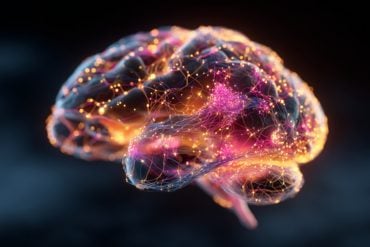Summary: A new study highlights how brain age models can track healthy infant development and reveal environmental influences. Using MRI data from over 600 term and preterm infants, researchers trained machine learning models to predict brain age and identify gaps between predicted and actual ages.
These brain age gaps can indicate whether an infant’s development is faster or slower than expected, with maternal age emerging as a significant influencing factor. Advanced brain development was linked to better cognitive abilities but poorer emotional regulation, suggesting that following normative developmental trajectories may be ideal.
Key Facts:
- Brain age models predict infant development from structural and functional MRI data.
- Maternal age strongly correlates with advanced structural brain development.
- Faster brain development benefits cognition but may hinder emotional regulation.
Source: Yale
The human brain undergoes significant development during the final prenatal months and through the first year of life. And while scientists have begun to map the developmental trajectories of this early period, blueprints of healthy development do not yet exist.
In a new study, Yale researchers demonstrate that models of brain age may be useful for tracking healthy brain development and they identify environmental factors that influence the pace of development.

They also reveal that advanced development isn’t universally positive.
For the study, published Nov. 26 in Nature Communications, researchers used structural and functional brain images from more than 600 term and preterm infants collected via magnetic resonance imaging (MRI) in the United Kingdom from the Developing Human Connectome Project.
With the images, researchers trained machine learning models to predict an infant’s brain age from neuroimaging data.
“Typically, researchers study brain age from either structural or functional imaging data, but here we used both,” said Huili Sun, lead author of the study and a Ph.D. candidate in the lab of senior author Dustin Scheinost, associate professor of radiology and biomedical imaging at Yale School of Medicine.
“Brain age is a novel concept in terms of taking all of the very high-dimension brain data and summarizing it into a single, but meaningful, number for an individual.”
When testing the models, the researchers found they were able to accurately predict infants’ ages whether these estimates were based on data from the whole brain or data from particular brain networks.
From there, the researchers investigated brain age gaps — the differences in the actual age of an infant and the age the models predicted them to be based on brain images. These gaps, said the researchers, can serve as an indicator of whether an infant is developing more quickly or slowly than they should be.
“We wanted to understand which type of factors might influence brain age gaps,” said Sun.
“Since the brain images were collected from infants shortly after birth, many of the environmental factors that might be at play would have had an influence during pregnancy. So we looked at maternal demographics and whether they had any associations with brain age gaps.”
Those demographics included maternal age, education, mental health history, physical conditions, and substance use. Maternal age had the strongest association, the researchers found, with higher maternal age associated with more mature structural brain age for term infants.
And while one might assume that an infant’s brain being more developed than expected could be a good thing, the researchers found that wasn’t always the case.
“We found that the older a child’s brain appeared to be in infancy, the better their cognitive abilities were as toddlers, but their ability to regulate their behavior and emotions was worse,” said Sun.
“So there are costs and benefits to advanced development and following the normative trajectory is probably best, according to our findings.”
Going forward, the researchers want to investigate brain age trajectory further into infancy and toddlerhood and to better understand what role genetics might play in brain age gaps.
Additionally, because the data from this study was collected in Europe, it will be important to conduct similar studies on brain development trajectory in children from different regions and from different cultures, said the researchers.
“Brain age and brain age gaps are a valuable tool for studying neurodevelopment in infants and children,” said Sun.
“And being able to establish normative trajectories of development in early life will help identify why and when individuals deviate from those trajectories and could point to how and when to intervene.”
About this machine learning and neurodevelopment research news
Author: Fred Mamoun
Source: Yale
Contact: Fred Mamoun – Yale
Image: The image is credited to Neuroscience News
Original Research: Open access.
“Brain age prediction and deviations from normative trajectories in the neonatal connectome” by Dustin Scheinost et al. Nature Communications
Abstract
Brain age prediction and deviations from normative trajectories in the neonatal connectome
Structural and functional connectomes undergo rapid changes during the third trimester and the first month of postnatal life.
Despite progress, our understanding of the developmental trajectories of the connectome in the perinatal period remains incomplete.
Brain age prediction uses machine learning to estimate the brain’s maturity relative to normative data.
The difference between the individual’s predicted and chronological age—or brain age gap (BAG)—represents the deviation from these normative trajectories.
Here, we assess brain age prediction and BAGs using structural and functional connectomes for infants in the first month of life. We use resting-state fMRI and DTI data from 611 infants (174 preterm; 437 term) from the Developing Human Connectome Project (dHCP) and connectome-based predictive modeling to predict postmenstrual age (PMA).
Structural and functional connectomes accurately predict PMA for term and preterm infants.
Predicted ages from each modality are correlated. At the network level, nearly all canonical brain networks—even putatively later developing ones—generate accurate PMA prediction.
Additionally, BAGs are associated with perinatal exposures and toddler behavioral outcomes.
Overall, our results underscore the importance of normative modeling and deviations from these models during the perinatal period.






